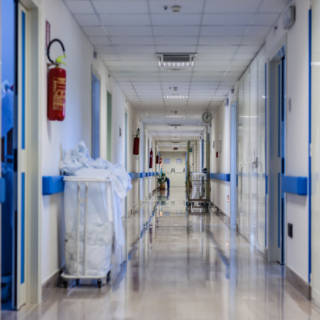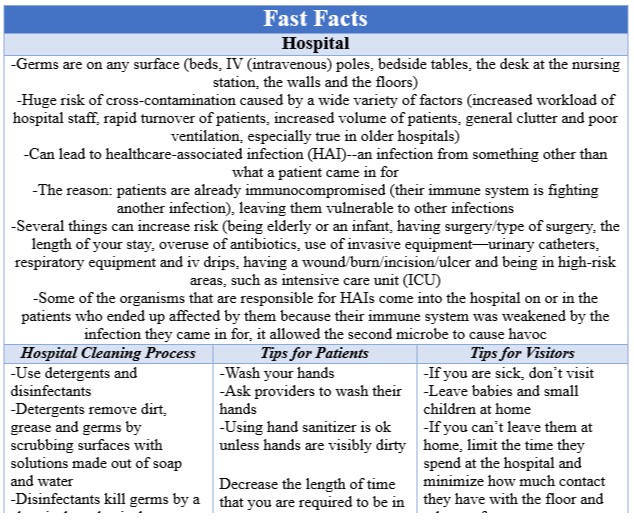How do you stay healthy while in one?
If you are sick enough that you need to be admitted to the hospital, then you are in the right place to receive the care that will help you get better. However, since hospitals treat people who are extremely sick, there are plenty of germs inside. While there is an army of staff that help to keep it as clean as possible, it can be a challenge to kill all of the germs. So, just how clean are hospitals? What can you do to protect yourself if you are a patient? How do you protect yourself if you’re a visitor?
 The Facts
The Facts
People go to the hospital when they are extremely sick and need acute medical intervention in order to become well again. This means there are plenty of germs in the hospital, which are spread very easily. Germs aren’t just on surfaces that patients come into contact with, such as beds, IV (intravenous) poles and bedside tables, but on any surface that you could think of, like the desk at the nursing station, the walls and the floors. Unfortunately, there is a huge risk of cross-contamination. This is caused by a wide variety of factors, like increased workload of hospital staff, rapid turnover of patients, increased volume of patients, general clutter and poor ventilation (especially true in older hospitals). All of these germs can lead to patients developing a healthcare-associated infection (HAI), which is an infection from something other than what they came in for. It is estimated by the Center for Disease Control (CDC) that 1 in 25 patients in the United States contract a HAI every day and of that, 1 in 9 will die. The reason for this is that patients are already immunocompromised (their immune system is fighting an infection) and this leaves them vulnerable to secondary infections. Several things can increase this risk, like being elderly or an infant, having surgery/type of surgery, the length of your stay, overuse of antibiotics, use of invasive equipment (urinary catheters, respiratory equipment and IV drips), having a wound/burn/incision/ulcer and being in high-risk areas, such as intensive care unit (ICU). Recently, it has been found that some of the organisms that are responsible for HAIs in some patients is not actually found in their hospital room or in any areas of the hospital. This has lead researchers to believe that the patient came into the hospital with those microbes already in their body and because their immune system was weakened by the primary infection, it allowed the second microbe to cause havoc. Even if this is the case, the secondary infection still gets qualified as a HAI because it isn’t why the patient initially sought treatment.
In order to combat this, hospital cleaning staff use two main products—detergents and disinfectants. They might seem like the same thing, but they are not. Detergents remove dirt, grease and germs by scrubbing surfaces with solutions made out of soap and water. Disinfectants kill germs by a chemical or physical intervention, such as wiping down a surface with a specific chemical or using a sterilization process to clean surgical instruments. It is important to note that different processes and different chemicals work on different types of germs. Some types of detergents and disinfectants are designed to target very specific organisms. While the power of these products is helpful, it is also a concern that they are contributing to the development of drug-resistant organisms. The CDC estimates 2 million Americans are sickened by antibiotic-resistant bacteria every year with 23,000 of those dying. This is why hospitals are constantly trying to find new and improved ways of cleaning.
Tips for Patients
The number one way to prevent any type of infection is through proper and effective handwashing. As a patient, not only is it important to practice this yourself, but to ask your healthcare providers to wash their hands or use antibacterial hand rub before they touch you. Hand sanitizer works really well at keeping hands clean, especially if it has a 70% or more alcohol content. It is key to note that if anyone’s hands are visibly dirty, then it is better if they wash their hands with soap and water. The next best thing you, as a patient, can do to lessen your risk of contracting an infection is finding ways to decrease the length of time that you are required to be in the hospital as this reduces the time you are exposed to the germs that are present. You can do this by taking charge of your care and learning about the medications you are on, such as what is their purpose, what side effects might they cause and how long will you need to take them. By knowing this information, you will be able to inform your doctor if you are having any complications, so they can change their plan of care accordingly. If you are bedridden, you can ask your doctor what steps are they taking to prevent you from getting blood clots, which can affect your legs/arms, heart, lungs or brain. If you aren’t bedridden, be careful when you are up walking because there are all sorts of tripping hazards that could cause you to fall. Also, non-slip socks are great at preventing falls, but they aren’t designed to be worn for extended periods of time. If you have been walking around, they have probably have collected a significant number of germs from the floor. The last thing you want to do is put them in your hospital bed and spread the germs to your sheets. Remember, it is ok to ask for a new pair of socks. By following these tips, you’ll be able to diminish your chances of having a complication that would require you to length your stay in the hospital.
Tips for Visitors
If you have a loved one that is in the hospital, the natural thing to do is to visit them. When you do, there are several things that you can do to prevent yourself from becoming sick and your loved one from getting a secondary infection. The first thing to remember is that if you are already sick, don’t visit because you can increase the chance of your loved one getting sicker. If you have a baby or small children, leave them at home. Remember, there are germs everywhere, especially on the floor and surfaces that children might come into contact with. If you can’t leave the child home, limit the amount of time they spend at the hospital and minimize how much contact they have with the floor and other surfaces. Try to limit the number of things that you touch, such as call bells, hospital machinery and linens. Also, try not to touch the patient too much because you could spread germs to them. Don’t touch your face with your hands if at all possible. If you need to cough or sneeze, use the crease of your elbow instead. After you touch anything, wash your hands thoroughly. If your loved ones are on isolation, wear whatever protective garments the hospital staff advises. This helps to prevent the spread of germs to and from your loved one. It is a good idea to wear closed-toed shoes. After your visit, disinfect your shoes when you get home, wash your clothes and take a shower to prevent germs from being spread around your home.
Hospitals are essential in providing care to people who are sick. However, they do have a high concentration of germs. If you have to spend time in one, the best way to keep loved ones and yourself safe is by washing your hands and limiting the amount of time that you need to be in one. By doing what you can, you’ll great reduce your chances of developing an unwanted infection.